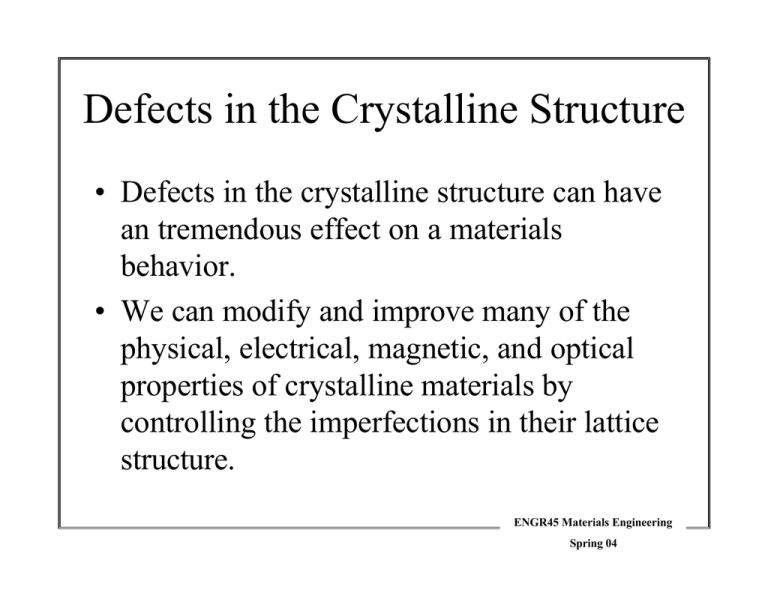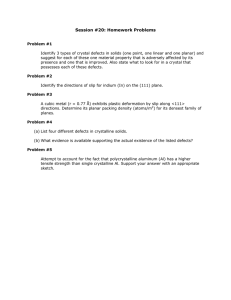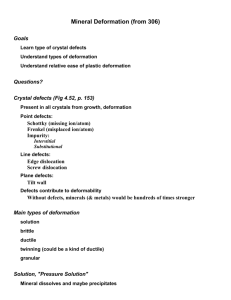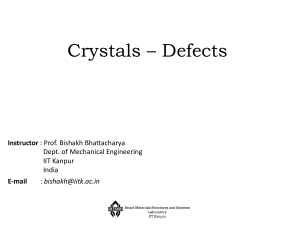Defects in the Crystalline Structure
advertisement

Defects in the Crystalline Structure • Defects in the crystalline structure can have an tremendous effect on a materials behavior. • We can modify and improve many of the physical, electrical, magnetic, and optical properties of crystalline materials by controlling the imperfections in their lattice structure. ENGR45 Materials Engineering Spring 04 Defects • Point Defects - Vacancies, Interstitial, and Substitutional • Line Defects (Dislocations) - Edge and Screw dislocations • Surface Defects - Grain Boundaries and Material Surface ENGR45 Materials Engineering Spring 04 Vacancy Defects • A vacancy defect is formed when an atom is missing from a normal atomic site in a crystalline structure. • The number of vacancies present in a material increases exponentially as the temperature increases. −Q nv = n exp RT ENGR45 Materials Engineering Spring 04 Interstitial Defects • An Interstitial defect is formed when an extra atom occupies a normally unoccupied site (interstitial site). • Since the interstitial atoms are larger then the interstitial sites the surrounding lattice is in compression. ENGR45 Materials Engineering Spring 04 Substitutional Defects • Substitutional defects are produced when one atom is replaced by a different type of atom. • If the substitutional atom is smaller then the original atom then the lattice is in tension. • If the substitutional atom is larger then the original atom then the lattice is in compression. ENGR45 Materials Engineering Spring 04 Compositions • Weight Percent • Atomic Percent - m1 ×100 m1 + m2 nm1 ' C1 = × 100 nm1 + nm 2 C1 = nm1 = Number of moles of m1 = nm2 Solid Solution m1 A1 m2 = Number of moles of m2 = A2 C1 + C2 = 100% C 1' + C '2 = 100% ENGR45 Materials Engineering Spring 04 Edge Dislocations • An extra 1/2 plane of atoms inserted into the lattice. • The Burgers Vector is perpendicular to the dislocation. ENGR45 Materials Engineering Spring 04 Screw Dislocations • The Burgers vector is parallel to the screw dislocation • The name is derived from the spiral path that is traced around the dislocation line. ENGR45 Materials Engineering Spring 04 Slip • Slip - The process by which a dislocation moves and deforms a material. • Slip direction - The direction in which a dislocation moves. • Slip Planes - The plane formed by the dislocation and the Burgers vector. • Slip Systems - The combination of the slip direction and slip plane make up the slip system. ENGR45 Materials Engineering Spring 04 Grain Boundaries • The crystalline structure of each grain is identical but there orientations are not • The grain boundaries is a narrow zone where the atoms are not properly spaced ENGR45 Materials Engineering Spring 04 Material Surface • This surface defect is the exterior of the material. The crystalline structure ends abruptly. • The atoms on the exterior surface do not have the proper coordination number so they are more reactive then the bulk material. ENGR45 Materials Engineering Spring 04



